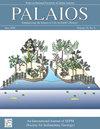印度satpura gondwana盆地中三叠统denwa组印度缩龙的地形学及沉积背景
IF 1.5
4区 地球科学
Q2 GEOLOGY
引用次数: 2
摘要
摘要:在印度萨特普拉-冈瓦纳盆地的上丹瓦组发现了一个由三叠纪角爬行动物印度Shringasaurus indicus的多个骨骼组成的骨床。单化石类骨床包含多个不同个体发生阶段的个体,表明印度施林加龙的放牧行为。牛群是一个男女混合的牛群。骨床中的成年和亚成年骨骼超过了幼年骨骼的数量。骨头的分布有点不均匀,不同个体的骨头混合在一起,几块骨头堆积在一起,这意味着大规模死亡。骨床产于细粒泥岩中,在水力上与洋流的长距离输送和浓缩不相容。沉积相分析表明,在两个ENE-WSW走向的河道充填杂岩之间的决口扇沉积中,骨床堆积并埋藏。北部河道充填杂岩是由单向流动形成的,河道侧向向南迁移,并伴有轻微的同期构造沉降。该河道水流多次决堤,导致决口扇堆积物逐渐发育。生活在常年航道附近的印度施林加龙群被集体淹死,尸体被困在决口扇沉积物的淤泥沉积物中。除了一个部分关节连接的骨骼外,其余的骨骼都没有关节连接,但仍然相连。这些骨头几乎没有显示出验尸后的变化。随着沉积物通过溢出通道的持续供应,骨头在完全脱离关节和扩散之前就被掩埋了。本文章由计算机程序翻译,如有差异,请以英文原文为准。
TAPHONOMY AND DEPOSITIONAL SETTING OF THE SHRINGASAURUS INDICUS (ARCHOSAUROMORPHA: ALLOKOTOSAURIA) BONEBED FROM THE MIDDLE TRIASSIC DENWA FORMATION, SATPURA GONDWANA BASIN, INDIA
Abstract: A bonebed of multiple skeletons of the Triassic horned reptile Shringasaurus indicus was discovered in the upper Denwa Formation, Satpura Gondwana Basin, India. The monotaxic bonebed contains multiple individuals of different ontogenic stages indicating herding behavior by Shringasaurus indicus. The herd was a mixed-sex herd. The adult and sub-adult bones in the bonebed exceed the number of juvenile bones. The distribution of the bones was slightly patchy, bones of different individuals were admixed, and several bones were piled up implying mass mortality. The bonebed occurs in a fine-grained mudrock that is hydraulically incompatible with long-distance transport and concentration by currents. Sedimentary facies analysis indicates that the bonebed accumulated and was buried in a crevasse splay deposit between two ENE-WSW trending channel-fill complexes. The northern channel-fill complex was formed by unidirectional flow with lateral channel migration towards the south and with minor contemporaneous tectonic subsidence. Repeated breaching of the levee by this channel flow led to the incremental development of the crevasse splay deposit. The herd of Shringasaurus indicus, which lived near to the perennial channel, was drowned en masse and the carcasses were trapped within the muddy sediments of the crevasse splay deposit. Apart from a partially articulated skeleton, the rest of the bones were disarticulated but remained associated. The bones show little evidence of post-mortem modifications. With a continuous supply of the sediments through the spillover channels, the bones were buried before complete disarticulation and dispersal had taken place.
求助全文
通过发布文献求助,成功后即可免费获取论文全文。
去求助
来源期刊

Palaios
地学-地质学
CiteScore
2.80
自引率
12.50%
发文量
40
审稿时长
6 months
期刊介绍:
PALAIOS is a monthly journal, founded in 1986, dedicated to emphasizing the impact of life on Earth''s history as recorded in the paleontological and sedimentological records. PALAIOS disseminates information to an international spectrum of geologists and biologists interested in a broad range of topics, including, but not limited to, biogeochemistry, ichnology, paleoclimatology, paleoecology, paleoceanography, sedimentology, stratigraphy, geomicrobiology, paleobiogeochemistry, and astrobiology.
PALAIOS publishes original papers that emphasize using paleontology to answer important geological and biological questions that further our understanding of Earth history. Accordingly, manuscripts whose subject matter and conclusions have broader geologic implications are much more likely to be selected for publication. Given that the purpose of PALAIOS is to generate enthusiasm for paleontology among a broad spectrum of readers, the editors request the following: titles that generate immediate interest; abstracts that emphasize important conclusions; illustrations of professional caliber used in place of words; and lively, yet scholarly, text.
 求助内容:
求助内容: 应助结果提醒方式:
应助结果提醒方式:


